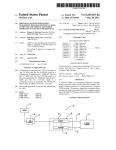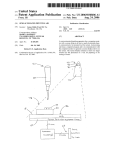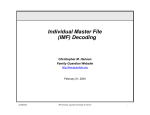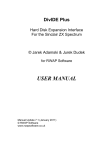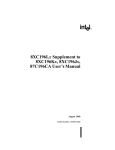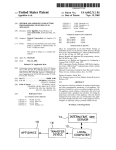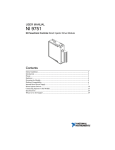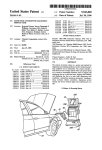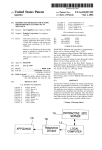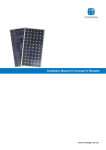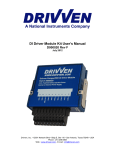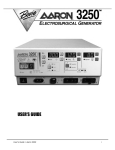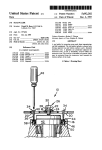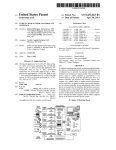Download f f 10 r 14 16 32/ K30 20 12
Transcript
USOO8924603B2 (12) Unlted States Patent (10) Patent N0.2 McClure et a]. (54) (45) Date of Patent: PROTOCOL ADAPTER FOR PASSING DIAGNOSTIC MESSAGES BETWEEN A HOST COMPUTER AND VEHICLE NETWORKS (52) OPERATING IN J1939 OR J1708 PROTOCOL G06F 15/1 73 G08G 1/017 us CL (2006.01) (2006.01) 701/29; 701/31; 701/33; 701/35; 701/36; (75) Inventors: gobegt?.glcflgre, DanV1(lileI,I\IIN (ISJS); ' “° ’ reenwoo ’ *Dec. 30, 2014 USPC ................. .. 710/16; 710/73; 710/74; 701/24; _ “1 US 8,924,603 B2 (U ) 701/53; 702/122; 702/123 (58) (73) Assignee: Dearborn Group, Inc" Farmington Hills MI (Us) ’ ( * ) Notice: Subject to any disclaimer, the term of this patent is extended or adjusted under 35 Field of Classi?cation Search USPC ........ .. 710/16, 73, 74; 701/24, 29, 31, 33, 35, 701/36; 702/122, 123 See application ?le for complete search history. (56) References Cited U.S.C. 154(b) by 0 days. _ _ _ _ _ U.S. PATENT DOCUMENTS Th1s patent 1s subJect to a term1nal d1s claimer. (21) (22) 4,602,127 A Appl_ No; 13/557 856 Filed 7/1986 Neely et al. 4,975,846 A 12/1990 Abe et a1. 5,077,670 A 12/1991 Takai et a1. ’ 5,491,418 A 2/1996 AlfBIO et a1. Jul 25 2012 5,541,840 A 7/1996 Gurne et a1. ’ (65) (Continued) Prior Publication Data US 2012/0290751A1 OTHER PUBLICATIONS Nov. 15, 2012 Dearborn Group, Inc.; Dearborn Group Technology, J l 850 Network Analysis Tool, JNAT User’s Manual Version 5.0; 1999; 63 pages; Related US. Application Data (60) Continuation of application No. 13/199,340, ?led on Farmmgton Hllls’ MIChlgan' Aug. 26, 2011, now Pat. No. 8,255,587, which is a continuation of application No. 12/799,739, ?led on P1’imary Examiner * Tammara Peyton Apr. 30, 2010, now Pat. No. 8,032,668, which is a continuation of application No. 12/002,427, ?led on (74) Attorney, Agent, or Firm *Warn Partners, P.C. D~ec.~17, 2007,~now Pat. No. 7,725,630, which is a (57) d1V1slon ofappllcatlon No. 10/888,432, ?led on Jul. 9, 2004, now Pat. No. 7,337,245, which is a continuation-in-part of application No. 09/532,718, ?led on Mar. 22, 2000, now Pat. No. 6,772,248. A protocol adapter for transferring diagnostic messages between networks within a vehicle and a host computer. The protocol adapter operates as a voltage translator to support (60) Provisional application NO' 60/126,588, ?led on Man 26 1 999 ’ (51) ' ABSTRACT J1708 software. The'protocol adapter also recognlzes when the protocol adapter 1s connected to a host computer runmng the J 1939 and/or J 1708 protocols and automatically switches Int C1 G06F 13/12 G06F 3/00 to that protocol. (2006.01) (2006.01) 10 Claims, 9 Drawing Sheets 18 f f 10 STORAGE r 14 16 HOST 32/ -—>| K30 /0 BOARD COMPUTER 20 12 ' IN - VEHICLE NETWORKS CPU BOARD L34 US 8,924,603 B2 Page 2 (56) References Cited U.S. PATENT DOCUMENTS 5,555,498 5,646,865 5,870,573 5,896,569 5,964,852 6,122,684 6,181,992 6,189,057 6,193,359 A A A A A A B1 B1 B1 9/1996 7/1997 2/1999 4/1999 10/1999 9/2000 1/2001 2/2001 2/2001 Berra et al. Alfaro et a1. Johnson Butler et a1. OveIton Sakura Gurne et a1. Schwanz et a1. Patil et a1. 6,195,359 6,321,151 6,407,554 6,526,340 6,571,136 6,608,554 6,772,248 7,337,245 7,725,630 7,817,019 8,255,587 * cited by examiner 2/2001 11/2001 6/2002 2/2003 5/2003 8/2003 8/2004 2/2008 5/2010 10/2010 8/2012 Eng et a1. ShulZ Godau et a1. ................ .. 324/503 Reul et a1. Staiger Lesesky et a1. McClure et a1. McClure et a1. McClure et a1. Lesesky McClure et a1. US. Patent Dec. 30, 2014 Sheet 1 0f9 7 32/ l/OBOARD \ A US 8,924,603 B2 CPUBOARD FIG-1 HOST STORAGE COMPUTER US. Patent Dec. 30, 2014 US 8,924,603 B2 Sheet 2 0f 9 82 wow M US. Patent Dec. 30, 2014 Sheet 3 0f9 TA+1708_A US 8,924,603 B2 TA1708_A 0pF 2 0 pF +5v1 4.7K [-50 4.7K r58 qua Q3 12% Chi l—h. $70 RXDINT FIG-3 US. Patent Dec. 30, 2014 Sheet 4 0f9 US 8,924,603 B2 k E§ hagE‘ % E == A3 5 IHI' I—HwLw FIG-4 4.7K PWRVEH 1K US. Patent Dec. 30, 2014 US 8,924,603 B2 Sheet 5 0f 9 my 3=2 EH §§ §=2 §\.. umk: R\ / . / . / _ / . /2\5AUA>.q\u I“ /<<<\5\3A(I%U I“ M /2>2AU$A>.d\e “ /<<(\5AU$A32 a: n- US. Patent Dec. 30, 2014 Sheet 6 0f 9 US 8,924,603 B2 8 “.8kg 3% m 5523E5%Q:3 US. Patent Dec. 30, 2014 US 8,924,603 B2 Sheet 7 0f 9 23E .1 v\gs Q23%? E“ |\O $5?“ 358H).38H3 al] a80umNE gmQ HE“W‘sH3%WSm§QSw88‘133a.s35% Fi?25 1.g)l}i 3%235%: m:E50 % 5é:5 I5l\\.)Q§ Es‘\$L6|5.u\EgoINE1n\E| |\ $2QO 21%asm~§. 5%Elsea29:9alv.aEx Ema“Emaan5: 2%m5I“BE5mm? m0nois>|V §21§Q5.a1253 QE § “EH3 s35.Fvm m W éw msw\sq§|!i,§Q%§< .n 52m? US. Patent Dec. 30, 2014 Sheet 8 0f9 US 8,924,603 B2 :5 I Q if. aaaaaaaaa?ggg?é ?g $EQ$§§$°€$§EEEEE 33$ 35-, L» / Q a: g 0( -15) A(1-75) RA RA E :2 US. Patent N“ Dec. 30, 2014 US 8,924,603 B2 Sheet 9 0f 9 a v NMg.1 aal IV >$ 9“ v%>$ mm3% m“gm“ RFR? an“ 2 a:3.IL: lEENail ED5 EmQ.an J a: % EE5 E w < 3%3bh9O WWW am W w 532% SE t N 3 AUQ2l mv“wa LN Em.Eq? L_.Hv an, 35%_ aQ aaEs5 $8 Em“ EEs“Nam US 8,924,603 B2 1 2 PROTOCOL ADAPTER FOR PASSING DIAGNOSTIC MESSAGES BETWEEN A HOST COMPUTER AND VEHICLE NETWORKS OPERATING IN J1939 OR J1708 PROTOCOL to detect the end of message, but also added an inherent delay between the vehicle data link and the ho st computer serial communication port. The 11939 protocol required that software had to be matched to the diagnostic tool for which it was written. Obso lete software had to be paired with legacy hardware, and new software had to be paired with new hardware. This required CROSS-REFERENCE TO RELATED APPLICATIONS that each diagnostic shop own and maintain several diagnos This application is a Continuation Application of US. tic tools. It would be desirable to have a protocol adapter that could operate as an old voltage translator to support obsolete patent application Ser. No. 13/199,340, ?led Aug. 26, 2011, which is a Continuation Application of US. Ser. No. 12/799, 739 ?led Apr. 30, 2010, which is a Continuation Application of US. Ser. No. 12/002,427 ?led Dec. 17, 2007, which is a software using the 11708 protocol, and recognize when the protocol adapter is connected to a host computer running new software to automatically switch to the 11939 protocol. Divisional Application of US. application Ser. No. 10/888, 432, ?led Jul. 9, 2004, which is a Continuation-in-Part Appli cation ofU.S. application Ser. No. 09/532,718, ?led Mar. 22, 2000, which claims the bene?t of US. Provisional Patent Application Ser. No. 60/126,588, ?led Mar. 26, 1999. BACKGROUND OF THE INVENTION SUMMARY OF THE INVENTION In accordance with the teachings of the present invention, a protocol adapter is disclosed for transferring diagnostic 20 messages between networks within a vehicle and a host com puter. The protocol adapter operates as a voltage translator to support 11708 software. The protocol adapter also recognizes 1. Field of the Invention This invention relates generally to a protocol adapter for passing diagnostic messages between networks within a vehicle and a host computer and, more particularly, to a 25 protocol adapter for passing diagnostic messages between networks within a vehicle and a host computer, where the protocol adapter includes a pass-through mode of operation where the protocol adapter emulates legacy protocol adapters so that state of the art host computers can communicate with 30 the vehicle networks using obsolete software. 2. Discussion of the RelatedArt Vehicles employ various networks and systems for diag nostics, analysis and monitoring of vehicle systems. These various networks are generally selectively connectable to an external host computer so that the operation of the vehicle networks can be monitored by an external system. These voltage of the 11708 protocol signals. The protocol adapter 35 further includes a static random access memory (RAM) cir cuit that provides temporary data storage and is connected to the CPU through data and address channels, a ?ash memory vehicle systems and networks operate under various proto cols, such as the 11708 and the 11939 protocols. Protocol adapters are known in the art that allow the host computer to when the protocol adapter is connected to a host computer running the 11939 and/ or 11708 protocols and automatically switches to that protocol. In one embodiment, the protocol adapter includes a control area network (CAN) transceiver circuit that provides an inter face between the vehicle network and the host computer when the vehicle network is operating in a 11939 protocol and a 11708 transceiver that provides an interface between the vehicle network and the host computer when the vehicle network is operating in a 11708 protocol. The 11708 trans ceiver circuit includes a voltage translator for translating the module that provides permanent storage of application data and loader application information, and a universal asynchro communicate with the vehicle networks through the proto nous receive and transmit (UART) circuit that provides com munication of asynchronous data to and from the host com cols. puter. One known type of protocol adapter for this purpose is the 11708 protocol adapter. The ?rst generation of the 11708 protocol adapterused for diagnostic purposes included a volt Additional advantages and features of the present inven tion will become apparent from the following description and appended claims, taken in conjunction with the accompany 40 45 ing drawings. age translator with a built-in-timer circuit that ?agged the end of a message. This protocol adapter design worked well for 11708 protocols because it and the standard serial communi BRIEF DESCRIPTION OF THE DRAWINGS cation port of the host computer were based on universal asynchronous receive and transmit (UART) technology hav ing different physical interfaces, i.e., different voltages. The 50 FIG. 1 is a block diagram of a protocol adapter system, according to an embodiment of the present invention, that timer circuit was needed to allow the host computer to rec transfers both 11708 and 11939 signals between a host com ognize the end of message as de?ned by the 11708 protocol. Most host computers, however, did not have adequate resources to comply with the rigid timing requirements needed for end of message detection. puter and a vehicle network; FIG. 2 is a schematic block diagram of an input/output 55 FIG. 3 is a schematic diagram of a 11708 transceiver circuit A second generation protocol for vehicle diagnostics pur in the I/O board shown in FIG. 2; FIG. 4 is a schematic diagram of a power supply regulator circuit in the I/O board shown in FIG. 2; poses is the 11939 protocol. With the 11939 protocol, there was no longer a basic compatibility between the known host computer serial communication port and the 11939 protocol. (I/O) board in the protocol adapter shown in FIG. 1; 60 FIG. 5 is a schematic diagram of an LED indicator circuit microprocessors in their diagnostic tools. These micropro in the I/O board shown in FIG. 2; FIG. 6 is a schematic block diagram of a central processing cessors would receive an entire message from one of the unit (CPU) board in the protocol adapter shown in FIG. 1; It therefore became necessary for protocol adapters to use supported links, and do message validation, including end of message detection. The microprocessor would then forward the message on to the appropriate communication channel if it did not detect an error. This alleviated the need for the timer 65 FIG. 7 is a schematic diagram of the central processing unit in the CPU board shown in FIG. 6; FIG. 8 is a schematic diagram of a static memory module circuit in the CPU board shown in FIG. 6; and US 8,924,603 B2 3 4 FIG. 9 is a schematic diagram of an I/O interface connector circuit in the CPU board shown in FIG. 6. -continued EXTINT—designates an external intenupt AD[O.15]—address data lines to transfer between the processor and memory LA[O.15]—latch address used to latch the desired memory bytes DETAILED DESCRIPTION OF THE EMBODIMENTS EPA3—input/output for high speed capture/compare channels EPA8—input/output for high speed capture/compare channels EPA9—input/output for high speed capture/compare channels The following discussion of the embodiments of the inven tion directed to a protocol adapter for transferring both 11708 and 11939 protocol diagnostic messages between networks within a vehicle and a host computer is merely exemplary in SCO—clock pin for SSIOO SDO—data pin for SSIOO SCI—clock pin for SSIOO SDI—data pin for SSIOO P2.4—standared bi—directional ports for data transfer nature, and is in no way intended to limit the invention or its applications or uses. TXD—used to transmit serial data RXD—used to receive serial data FIG. 1 is a block diagram of a system 10 for transferring diagnostic signals between vehicle networks 12 in a vehicle to an external host computer 14 through a protocol adapter 30. TXCAN—used to transmit CAN signal RXCAN—used to receive CAN signal A[9.15]—high level address for selecting large byte operations Such diagnostic messages can be any signals for monitoring any suitable vehicle network within the vehicle for diagnos tics and/or maintenance purposes, as would be well under stood to those skilled in the art. The host computer 14 can be any host computer known in the art used for this purpose, HDWLRST’g-active love hardware reset FLASHiUPPER—FLASH upper byte 20 including state of the art host computers and obsolete host computers. The host computer 14 includes an RS-232 I/O port 1 6 that provides an RS -232 interface to the host computer 14. The RS-232 port 16 provides direct access to the 11708/ the processor and memory A[1.15]—address signal used to select the desired memory allocation area RS-485 link. The signals received and analyzed by the host 25 computer 14 can be stored in any suitable storage device 18, such as a display or magnetic tape. The signals used by the vehicle networks 12 can be of any particular vehicle protocol, including the 11708 protocol provided on line 20 and the 11939 protocol provide on line 22. 30 According to the invention, the protocol adapter 30 is com allows all compliant software applications and hardware interface adapters to be interchangeable. The protocol adapter 30 is capable of performing electronic control module (ECM) emulation, analysis of network message loading, simulation of message traf?c loading of an in-vehicle network, inventory 35 CS*—active low chip select RESET—signal used for reset INTR—interrupt line to processor SOUT—data out 40 DTR*—active low enable data terminal ready RTS*—active low enable ready to send MBAUD—used to set the processor in high speed mode. Unused in this application. SIN—data in DSR*—active low enable data set ready CTS*—active low enable clear to send The protocol adapter 30 includes an I/O sub-assembly 45 EPA3—input/output for high speed for capture/compare channels EPA8—input/output for high speed for capture/compare channels EPA9—input/output for high speed for capture/compare channels P2.4—PC LED control UARTLS OUT-UART data out UARTiDTR’g—active low enable UART data terminal ready UARTiRTS’g—active low enable UART ready to send UARTLS IN-UART data in UARTLDSR’g—active low enable UART data set ready 50 55 compatibility. The I/O board 30 and the CPU board 34 use the following list of signals: 60 ACH[2.7]—inputs for the malogdigital converter RESET*—active low signal issued to reset the processor READY—signal used to lengthen memory cycles for slow memory RD*—active low signal used for external memory reads WRH*—active low signal used to designate high—byte writes WR* —active low signal used for external writes FLASHiDE*—active low FLASH data enable FLASHLWE’g—active low FLASH write enable processor and memory management, ECM code testing, a gateway between net works and vehicle maintenance status checks. board 32 and a CPU sub-assembly board 34, both of which will be described in detail below. When the vehicle networks 12 use the 11708 protocol, the protocol adapter 30 can operate in a pass-through mode where the 11708 signals on the line 20 are passed through a voltage translator directly to an RS-232 transceiver in the I/O board 32. With the 11708 protocol, the protocol adapter 30 can also operate under the control of an embedded processor where the 11708 signals on the line 20 are passed through a voltage translator to be processed in the CPU board 34 and routed to an RS -232 transceiver (discussed below) in the I/O board 32. If the vehicle networks 12 are using the newer 11939 protocol, the 11939 signals on the line 22 are processed in the CPU board 34 to provide the 11939 CE*iLOWER—active low chip enable for lower byte DE*iLOWER—active low data enable for lower byte WE*iLOWER-active low write enable for lower byte CE*iUPPER—active low chip enable for upper byte DE*iUPPER—active low data enable for upper byte WE*iUPPER—active low write enable for upper byte FLASHLUPPER—FLASH upper byte write enable FLASHiCE’g—active low FLASH chip enable A[1.3]—address signal used to select the desired allocation area D[O.7]—data signal used to transfer data bi—directionally between the patible for both the 11708 protocol and the 11939 protocol. The protocol adapter 30 provides a “pass-through” interface so that various compliant applications from various develop ers can use any of the unique developer applications. This FLASHLCS’g—active low enable FLASH chip select RAMLCS’g—active low enable RAM chip select UARTLCS’g—active low enable UART chip select D[O.15]-data signal used to transfer data bi—directionally between 65 UARTLCTS’g—active low enable UART clear to send FIG. 2 is a schematic block diagram of the I/O board 32. The (I/O) board 32 includes an external I/O interface circuit 40, an RS-232 transceiver circuit 42, a power supply regulator circuit 44, a controller area network (CAN) transceiver circuit 48 for the 11939 protocol, a 11708 transceiver circuit 50 including a voltage translator, an LED indicator circuit 52 and input and output ports 54 and 56 interconnected as shown. The external I/O interface circuit 40 provides the interface connection between the various circuits in the I/O board 32 and the connections to the host computer 14 and the vehicle networks 12. The RS-232 transceiver circuit 42 provides an RS-232 interface between the vehicle networks 12 and the host computer 14. The CAN transceiver circuit 48 provides a CAN interface between the vehicle networks 12 and the host computer 14 US 8,924,603 B2 5 6 when the vehicle networks 12 are operating in the 11939 protocol. In one embodiment, the CAN transceiver is the model P82C25 1 T, well known to those skilled in the art. The monitors the data so as to provide the 11708 de?ned timing signals on any or all of the RS-232 hardware handshake 11708 transceiver circuit 50 provides the 11708 protocol FIG. 8 is a schematic diagram of the static RAM circuit 92, and includes a memory chip 110 andAND gates 112, 114 and signals. interface between the vehicle networks 12 and the host com puter 14. FIG. 3 is a schematic diagram of the 11708 trans ceiver circuit 50 and includes a voltage translator 68 and an input buffer 70 electrically interconnected, as shown. In one 116 electrically interconnected as shown. In one embodi ment, the memory chip 110 is the model TC551664B1-20, well known to those skilled in the art. The memory chip 110 is used for temporary data storage and is connected to the CPU 100 through the data and address channels. Once a memory allocation area is speci?ed through the address chan nel, data can be read or written through the data channel. Data embodiment, the voltage translator 68 is the model SN75176, well known to those skilled in the art. Both the transceiver circuits 48 and 50 include transmit mailboxes for transmitting 11708 and 11939 messages to the signals D(0-15) are used to transfer data bi-directionally between the CPU 100 and the memory chip 110. Address signals A(1-15) are used to select the desired memory allo cation area in the memory chip 110. The static RAM circuit 92 provides space reserved in the adapter’s memory for the temporary storage of data for the transmit and receive mailboxes. The static RAM circuit 92 networks 12 and receive mailboxes for receiving 11708 and 11939 messages from the networks 12. The protocol adapter 30 allows the user to customize each transmitted message. The 11708 or 11939 message to be transmitted may include the relative time to the adapter timer, when the message transmission is to begin, the number of times the message is to be sent, the desired time interval between transmissions, 20 announcing a successful transmission, the number of times the message should be sent before auto-deletion occurs, and whether to enable a call back announcing the time of message deletion. The 11708 or 11939 message received may include mailbox data, storage for oversized messages, such as 11939 transport protocol messages, and the concatenation of small 25 which protocol to scan, which bits should be masked by hardware-level ?ltering, which bits should be matched by hardware-level ?ltering, what information, such as mailbox 30 cation will be noti?ed when a message is received, such as transparent update, receive call back, polling, etc. FIG. 4 is a schematic diagram of the power supply regula tor circuit 44 and includes a voltage regulator 60 intercon nected with other circuit elements, as shown. The power 35 supply regulator circuit 44 converts a vehicle battery voltage to a regulated 5V DC for operation of the adapter 30. FIG. 5 is a schematic diagram of the LED circuit 52. The LED circuit 52 includes four LED control lines coupled to four LEDs 72, 74, 76 and 78 through input buffers 80, 82, 84 and 86, respectively. In this embodiment, the LED 72 indi cates that the protocol adapter 30 is being powered, the LED 45 50 CPU 100 to serial data to the host computer 14, and vice versa. FIG. 7 is a schematic diagram of the CPU 100, and includes a microprocessor 102 and two input/output chips 104 and 106 electrically coupled as shown. In this embodiment, the micro processor 102 is the model 87C196CA and the chips 104 and 106 are the model 74HC573. In the pass through mode, the microprocessor 102 delivers data directly to the 11708 trans ceiver circuit 50 to the RS-232 transceiver circuit 42, and ment, the interface chip 120 is the model 74HC241. The interface circuit 98 provides interfacing between the CPU 1 00 and the I/O board 32. The foregoing discussion discloses and describes merely exemplary embodiments of the present invention. One skilled in the art will readily recognize from such discussion and from the accompanying drawings and claims that various changes, modi?cations and variations can be made therein without departing from the spirit and scope of the invention as de?ned in the following claims. What is claimed is: ule 94 is used for program storage. The module 94 is respon sible for the permanent storage of the application data and loader application information. The module 94 allows the protocol adapter 30 to be updated with new ?rmware in the ?eld. The uploaded ?rmware is stored in the RAM circuit 92. The UART circuit 96 is used for communication of asyn chronous data to and from the programmable controller 14. The UART circuit 96 is used to convert parallel data from the replace legacy hardware with the protocol adapter 30 and maintain compatibility with their original software. FIG. 9 is a schematic diagram of the CPU I/O interface circuit 98, and includes an interface chip 120. In one embodi the protocol adapter 30 is operating in the 11708 protocol. FIG. 6 is a schematic block diagram of the CPU board 34. The CPU board 34 includes a CPU 100, a device decoder circuit 90, a static RAM circuit 92, a ?ash memory module 94, a UART circuit 96 and a CPU I/O interface circuit 98 electrically interconnected as shown. The ?ash memory mod messages. The protocol adapter 30 accommodates these over sized messages by putting the 11708 mailbox into extended mode and attaching it to a location in the static RAM circuit 92. The 11939 transport layer also makes use of the RAM circuit 92 to ensure that transport timing requirements are met. The storing of multiple messages in the static RAM circuit 92 reduces multiple reads and writes to the adapter hardware. The concatenation of these short messages reduces the overhead on the serial port. The static RAM circuit 92 allows users to replace legacy hardware with an interface that can support existing software. Consequently, users can 40 74 indicates a link to the RS-232 port 16 of the host computer 14, the LED 76 indicates that the protocol adapter 30 is operating in the 11939 protocol and the LED 78 indicates that messages. Sometimes both the 11708 and the 11939 protocols trans mit oversized messages. A normal 11708 message may be up to 21 bytes long. However, special modes may utilize longer number, time stamp, identi?er, length of data, etc., should be sent to the host immediately upon receipt, and how the appli provides ?exibility for transmitting and receiving messages, regardless of the 11708 or 11939 vehicle protocol, by provid ing a temporary message storage location, redirection of the ID and data to be sent, the conditions for a call back 55 1. A protocol adapter for transferring diagnostic messages between a vehicle network in a vehicle and an external host computer, said adapter comprising: a plurality of transceiver circuits for providing an interface between the vehicle network and the host computer in at 60 least two protocols being communicated between the vehicle network and the host computer; wherein the adapter automatically switches to one or more of the plurality of protocols the host computer is using. 65 2. The protocol adapter according to claim 1 one of said plurality of transceiver circuits further comprising an RS-232 transceiver, said RS-232 transceiver circuit providing an interface to an RS-232 port on the host computer. US 8,924,603 B2 7 8 3. The protocol adapter according to claim 1, further com prising a central processing unit (CPU), said CPU controlling the operation of the plurality of transceiver circuits to auto matically switch between the plurality of transceiver circuits, depending on which of the plurality of protocols the host 7. The protocol adapter according to claim 3, further com prising a universal asynchronous receive and transmit (UART) circuit, said UART circuit providing communication of asynchronous data to and from the host computer. 8. The protocol adapter according to claim 3, further com prising a CPU l/O interface circuit, said CPU l/O interface computer is using. circuit providing an interface between the CPU and the trans ceiver circuits. 4. The protocol adapter according to claim 3, further com prising a static random access memory (RAM) circuit, said RAM circuit including a RAM that provides temporary data storage and is connected to the CPU through data and address 9. The protocol adapter according to claim 3, further com prising a device decoder, said device decoder decoding input signals sent to the CPU. channels. 5. The protocol adapter according to claim 4 wherein the RAM circuit further provides redirection of mailbox data, storage for oversized messages and the concatenation of small messages. 6. The protocol adapter according to claim 3, further com prising a ?ash memory module, said ?ash memory module providing permanent storage of application data and loader application information. 15 10. The protocol adapter according to claim 1, one of said plurality of transceiver circuits further comprising a 11708 transceiver circuit, said J 1708 transceiver circuit providing an interface between the vehicle network and the ho st computer when the vehicle network is operating in a 11708 protocol and the protocol adapter is operating in a pass-through mode, said J 1708 transceiver circuit including the voltage translator for translating the voltage of the 11708 protocol signals. * * * * *















